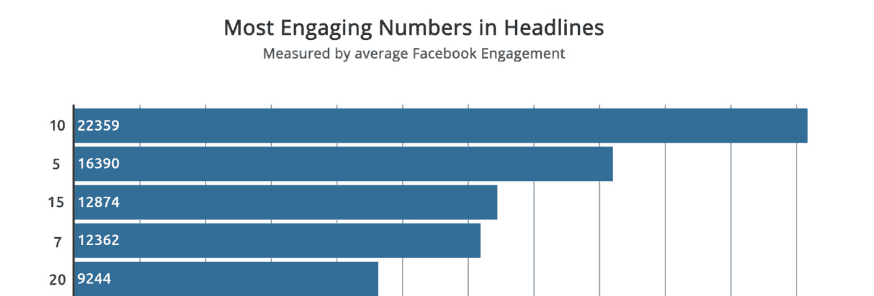Last week, I shared a few things I’ve learned over the years that have helped me write regular blogs and content.
Getting inspiration and sitting down and putting your thoughts on paper is just the first step of the journey. The second, arguably more difficult step, is getting people to actually read the article you’ve written!
At some point, we’ve all been sucked into reading an article by no more than its headline. It won’t surprise you to know that there’s research and science behind this, so this week I’ll share 10 ways that you can rewrite your article headlines so it’s more likely that people will read them.
1. Use a number
US digital agency BuzzSumo analysed 100 million article headlines and concluded that ‘it is well known that list posts gain above-average social shares’.
Using a number in your article headline is a tried and tested way of getting more readers. Indeed, this research found that the most engaging phrase to start a headline with was: ‘[number] reasons why…’.
A few little things to remember:
- Make sure the number is at the start of the headline (’10 sneaky ways…’)
- Write the number in digits, not words (‘10’ not ‘ten’)
- Think about using big numbers, as these promise more value to readers (although the best number to use is 10, followed by 5 and 15).

2. Promise a benefit
A good headline lets your reader know that there is value in your article. And, more importantly, it lets them know it’s valuable to them.
Your headline should state that a reader will get some good advice, learn something, or be highly entertained and moved by what they are about to read.
Answer the question: ‘what’s in it for me?’
3. Ask a question
At some time, you’ve probably found yourself clicking on a headline if it asks a current, topical or pertinent question that you’re interested in, and promises to answer it.
The key here is to provide a full and comprehensive answer. If you don’t, your reader will leave disappointed. Only use this technique if you are fully answering the question and providing useful information.
4. Increase the length of the title
In terms of a headline length, the perceived wisdom is often ‘the shorter, the better’.
However, this is not always true. The BuzzSumo research of 100 million article titles found that articles with twelve to eighteen words in the headline received, on average, the highest number of Facebook engagements.
This is equivalent to around 80 to 95 characters. So, don’t be afraid to go with a longer title.
5. Be honest
Headlines are designed to connect a reader with information that they want or need.
So, a great headline is honest and clearly articulates what the reader will get by viewing it. A clear purpose that matches headline to content means that readers will stay longer and share more.
6. Suggest readers are missing out
Fear of missing out (FOMO in web-speak) can be a powerful motivation for many readers. So, playing on the fear of missing out can be a good way of getting people to read your content.
Examples include:
- The one financial planning tip you shouldn’t forget
- Why you need to think about your retirement planning right now
7. Be controversial
A quick way to grab someone’s attention is to ask a challenging question or to make a controversial statement. It makes readers curious, and they start thinking about their own position on the subject.
In a world of competing headlines, a controversial stance (‘Why Inheritance Tax should be abolished by Christmas’) helps you stand out from the crowd – as long as you provide a coherent and interesting argument why. Otherwise, it’s just clickbait.
8. Teach a skill
We all enjoy learning new skills that complement our goals and our lives. So, if your article is providing advice or guidance, share this in the headline.
Headlines that work well contain:
- A beginner’s guide to…
- DIY…
- Introduction to…
- …in 5 minutes
9. Create a sense of urgency
Adding urgency in a headline normally just means that you add the word ‘now’ or ‘today’ at the end of it.
For example, ‘10 ways to grow your blog right now’ is far more compelling than ‘10 ways to grow your blog’.
Your other option is to create urgency by implying the effects of a reader’s ignorance; for example, ‘10 mistakes you don’t want to make when writing a blog’.
10. Use a formula
If you’re struggling to come up with headlines that resonate with your readers, there are a few formulas you can use. Here are a couple:
- Number + Adjective + Noun + Keyword + Promise
10 sneaky ways to make more people read your article right now
- How to + Action + Keyword + Promise
How to write an amazing headline for your next blog post
Why you should contact us for great content right now
As I said at the start of this piece, these are just some of the tips that can help you create engaging headlines that make readers want to view your articles.
Of course, if you don’t have the time or inclination to write but still want the benefits of producing and distributing content, you could outsource the task. Our Yardstick Membership service allows you to do just that. To learn more about the benefits and cost please click here.


